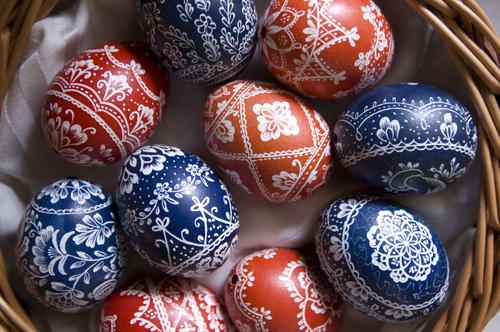
DAVID ADAMS looks at the Easter egg and some of its associated traditions…
This Easter children (and adults) all over the world will gorge themselves on chocolate in the form of Easter eggs. But how did eggs come to be associated with Easter? And when did the first chocolate eggs start appearing?
• The egg has long been held to be a symbol of new life, so for Christians that means the death and resurrection of Jesus Christ. In terms of decorated eggs, it’s suggested that the hollow egg represents the empty tomb and the cracking of the shell Jesus’ resurrection.

• While the practice of decorating eggs goes back to ancient times, the first Christians to start dying eggs red at Easter in memory of the blood of Christ were apparently based in Mesopotamia before the practice spread to other branches of the church, including the Orthodox and Roman Catholic churches.
• Orthodox tradition holds that the association of eggs with Easter came from when Mary Magdalene took a basket of eggs to share with the other women for breakfast at the tomb of Jesus and that when she saw the risen Christ, the eggs miraculously turned red. Another story has Mary meeting the Emperor of Rome and recounts how, after she had greeted him with the words ‘Christ is risen’, the emperor had pointed to a nearby egg and denied her comments, saying Christ was no more risen than the egg was red. At which the egg promptly turned blood red.
• Easter celebrations involving decorated eggs may also have to do with the fact that eggs were traditionally not permitted to be eaten during the Lenten period (using up eggs before Lent was apparently one of the reasons for Shrove or ‘Pancake’ Tuesday), meaning there would be a surplus of eggs for families with chickens by the time Easter arrived and the Lenten restrictions were lifted.
• Traditional activities involving the use of eggs around Easter time include hunts, egg rolling competitions (among the most famous is the annual Easter Egg Roll at the White House in the US, held since 1878), and, in northern England, egg tapping or ‘jarping’.
• The first chocolate Easter eggs were produced in Europe in the early 19th century. In the UK JS Fry and Sons produced the first commercial chocolate eggs in Bristol in 1873. Deep-fried chocolate Easter eggs are apparently a more recent Scottish invention.
• The concept of the Easter Bunny is these days intrinsically linked with Easter eggs and while its origins are somewhat shrouded in mystery, one version has the idea of the Easter bunny stemming from a German Lutheran tradition surrounding an Easter rabbit or hare who judges whether children were good of disobedient at Easter and rewards those who pass the test with presents (ie Easter eggs) by laying them in nests the children have prepared.
• The most famous decorated eggs were created at the end of the 19th and into the early 20th century by Russian jeweler Peter Carl Fabergé who created a series of jewel-encrusted Fabergé eggs for the tsars to give to family members as Easter gifts.
• The most expensive chocolate Easter eggs ever created to date were made by UK firm Choccywoccydoodah. Sold as a trio, they were inspired by Fabergé eggs and went on the market last year with prices starting at £25,000.
• In Australia, the idea of the Easter bunny, meanwhile, has been challenged in recent years by the creation of the Easter bilby (a endangered native animal) – with Haigh’s Chocolates first making chocolate Easter bilbies in 1993 (and part of the proceeds from the bilbies going back to support environment group Rabbit Free Australia).





